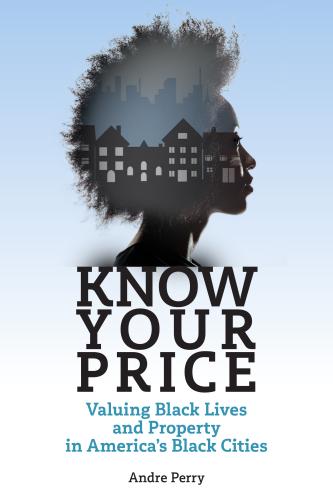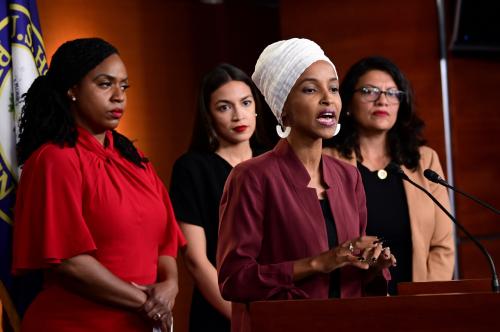At Tuesday’s State of the Union address, President Donald Trump used parts of his speech to make inroads into the Black electorate, a demographic where he faces his worst approval numbers—as low as 9%, according to some polls.
Trump introduced Army veteran Tony Rankin, who lost his home after battling addiction, and spoke on how Rankin was able to find a job because of the Opportunity Zones initiative created by the 2017 tax legislation. Trump also honored Charles McGee, one of the last surviving Tuskegee Airmen, and McGee’s great-grandson Iain Lanphier, an eighth grader from Arizona and aspiring Space Force member. These were among several moments in the address where Trump recognized Black people’s contributions.
Yet, in an economy that many would call “booming,” Black unemployment rates remain double that of whites. Black homeownership rates have fallen to pre-1968 levels, before the Fair Housing Act outlawed housing discrimination. And the rising college attendance rate for Black students has been hamstrung by the soaring costs of college.
Black people need more than symbolism and representation. We need policy that will address the persisting structural inequality that predated Trump and the 2016 election.
To be clear, Trump is not the only 2020 presidential candidate attempting to use symbolism to win over Black voters. One day before this year’s Martin Luther King Jr. Day, Democratic candidate Mike Bloomberg unveiled his Greenwood Initiative—a plan to uplift the economic prospects of Black Americans—at the Greenwood Cultural Center in Tulsa, Okla., home to a successful business strip in the early 20th century known as Black Wall Street. On June 1, 1921, white mobs burned and pillaged Black Wall Street’s banks, businesses, and homes in one of the most dramatic and violent strippings of Black lives and property in America. An uncounted number of people were killed, thousands arrested and detained, and an immeasurable amount of wealth was stolen.
Before she ended her candidacy, Sen. Kamala Harris of California campaigned at Howard University—a historically Black university and her alma mater—in Washington, D.C., aka “Chocolate City.” And in July, South Bend, Ind. Mayor Pete Buttigieg announced his proposal for black empowerment, dubbed the Douglass Plan—a homage to historic abolitionist and civil rights leader Frederick Douglass.
Most voters are skeptical of these symbolic gestures. A 2018 Rasmussen survey found that “71% of Likely U.S. Voters think most politicians raise racial issues to get elected, not to address real problems.” And posturing from presidential candidates can be dangerous for Black people if it leads to half measures that inhibit substantive policy.
Black people need more than symbolism and representation. We need policy that will address the persisting structural inequality that predated Trump and the 2016 election.
For instance, last year Harris, Buttigieg, and Sen. Elizabeth Warren all released housing proposals adapted from old “redlining” maps. Redlining was the practice of outlining neighborhoods with sizable Black populations in red ink on maps as a warning to mortgage lenders, effectively isolating Black people in areas that would suffer lower levels of investment than their white counterparts. Harris, Buttigieg, and Warren were using the redlining maps to attempt to rectify the Black homeownership gap by reinvesting in those areas, but what they didn’t realize is that, today, only 28% of residents in formerly redlined areas are Black—less than the white and Latino or Hispanic populations there, according to my research.
It’s certainly not surprising (and it’s even predictable) that the candidates are choosing Black heroes, Black-majority cities, and historic Black institutions as backdrops to announce plans and signify their assurance to the Black electorate. The Democrats’ loss in 2016 is a case study in how the party did not get Black voters out to the polls in states such as Michigan, Wisconsin, and Ohio. And Trump recognizes that, in 2020, Black voters in those critical states could upend his presidency.
Put simply, Black voters need fewer symbols and more substance. The deliberate devaluation of Black property, firms, and people by both Republican and Democratic policymakers created the negative conditions in Black-majority cities that we see today. As ugly as the Black Wall Street massacre was, racism baked into public policy has destroyed many more communities and lives.
In a 2018 report, we found that owner-occupied homes in Black neighborhoods are undervalued by $48,000 per home on average, even after controlling for factors such as housing quality, neighborhood quality, education, and crime. This amounts to a whopping $156 billion in cumulative losses. In the Pittsburgh metro area, homes are worth roughly 12% less in Black neighborhoods, or about $12,000 per home.
In a forthcoming report, the same author team at Brookings found a similar gulf in the business sector: Minority-owned businesses, despite earning significantly higher Yelp ratings than white-owned firms, suffered less revenue and slower business growth if they were located in a primarily Black neighborhood. Business in these places suffer a location penalty resulting in a loss of $1 to $4 billion a year.
Black people suffer when candidates don’t authentically value them. Instead of symbolism, candidates must show how their policies will create jobs, wealth, and protection for Black communities.
Both parties should not discount the recent election results in which Black votes were crucial to the outcome. Last November, Democratic Louisiana Governor John Bel Edwards successfully fended off his Republican challenger in a runoff election, thanks to heightened turnouts in urban centers in New Orleans and Baton Rouge—two of the largest Black-majority cities in the country. And in the 2017 special election for one of Alabama’s U.S. Senate seats, Democrat Doug Jones won in large part due to overwhelming support of Black voters, specifically Black women.
Black people suffer when candidates don’t authentically value them. Instead of symbolism, candidates must show how their policies will create jobs, wealth, and protection for Black communities. These are quantifiable and achievable goals, and have repeatedly been delivered for white citizens. It’s past time the same was true for Black America.







Commentary
The 2020 presidential candidates need to stop using Black Americans as symbols, and deliver substance
February 6, 2020